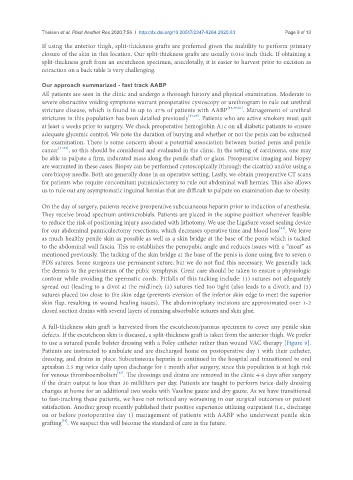Page 653 - Read Online
P. 653
Theisen et al. Plast Aesthet Res 2020;7:56 I http://dx.doi.org/10.20517/2347-9264.2020.83 Page 9 of 13
If using the anterior thigh, split-thickness grafts are preferred given the inability to perform primary
closure of the skin in this location. Our split-thickness grafts are usually 0.016 inch thick. If obtaining a
split-thickness graft from an escutcheon specimen, anecdotally, it is easier to harvest prior to excision as
retraction on a back table is very challenging.
Our approach summarized - fast track AABP
All patients are seen in the clinic and undergo a thorough history and physical examination. Moderate to
severe obstructive voiding symptoms warrant preoperative cystoscopy or urethrogram to rule out urethral
stricture disease, which is found in up to 47% of patients with AABP [13,29,30] . Management of urethral
strictures in this population has been detailed previously [17,29] . Patients who are active smokers must quit
at least 4 weeks prior to surgery. We check preoperative hemoglobin A1c on all diabetic patients to ensure
adequate glycemic control. We note the duration of burying and whether or not the penis can be exhumed
for examination. There is some concern about a potential association between buried penis and penile
cancer [31,32] , so this should be considered and evaluated in the clinic. In the setting of carcinoma, one may
be able to palpate a firm, indurated mass along the penile shaft or glans. Preoperative imaging and biopsy
are warranted in these cases. Biopsy can be performed cystoscopically (through the cicatrix) and/or using a
core biopsy needle. Both are generally done in an operative setting. Lastly, we obtain preoperative CT scans
for patients who require concomitant panniculectomy to rule out abdominal wall hernias. This also allows
us to rule out any asymptomatic inguinal hernias that are difficult to palpate on examination due to obesity.
On the day of surgery, patients receive preoperative subcutaneous heparin prior to induction of anesthesia.
They receive broad spectrum antimicrobials. Patients are placed in the supine position whenever feasible
to reduce the risk of positioning injury associated with lithotomy. We use the LigaSure vessel sealing device
[33]
for our abdominal panniculectomy resections, which decreases operative time and blood loss . We leave
as much healthy penile skin as possible as well as a skin bridge at the base of the penis which is tacked
to the abdominal wall fascia. This re-establishes the penopubic angle and reduces issues with a “moat” as
mentioned previously. The tacking of the skin bridge at the base of the penis is done using five to seven 0
PDS sutures. Some surgeons use permanent suture, but we do not find this necessary. We generally tack
the dermis to the periosteum of the pubic symphysis. Great care should be taken to ensure a physiologic
contour while avoiding the spermatic cords. Pitfalls of this tacking include: (1) sutures not adequately
spread out (leading to a divot at the midline); (2) sutures tied too tight (also leads to a divot); and (3)
sutures placed too close to the skin edge (prevents eversion of the inferior skin edge to meet the superior
skin flap, resulting in wound healing issues). The abdominoplasty incisions are approximated over 1-2
closed suction drains with several layers of running absorbable sutures and skin glue.
A full-thickness skin graft is harvested from the escutcheon/pannus specimen to cover any penile skin
defects. If the escutcheon skin is diseased, a split-thickness graft is taken from the anterior thigh. We prefer
to use a sutured penile bolster dressing with a Foley catheter rather than wound VAC therapy [Figure 9].
Patients are instructed to ambulate and are discharged home on postoperative day 1 with their catheter,
dressing, and drains in place. Subcutaneous heparin is continued in the hospital and transitioned to oral
apixaban 2.5 mg twice daily upon discharge for 1 month after surgery, since this population is at high risk
[13]
for venous thromboembolism . The dressings and drains are removed in the clinic 4-6 days after surgery
if the drain output is less than 30 milliliters per day. Patients are taught to perform twice-daily dressing
changes at home for an additional two weeks with Vaseline gauze and dry gauze. As we have transitioned
to fast-tracking these patients, we have not noticed any worsening in our surgical outcomes or patient
satisfaction. Another group recently published their positive experience utilizing outpatient (i.e., discharge
on or before postoperative day 1) management of patients with AABP who underwent penile skin
grafting . We suspect this will become the standard of care in the future.
[34]

